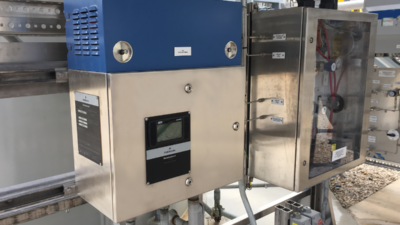Borrowing from the software programmer vernacular, writers of press releases, and advertisements frequently get caught in the dreaded "continuous loop," spewing forth descriptive adjectives until they run out of breath and have to insert a comma or period (Esc key) before they pass out. My eighth-grade English teacher used a red pencil to scribble "Run-on sentence" across these sorts of w...
|
Borrowing from the software programmer vernacular, writers of press releases, and advertisements frequently get caught in the dreaded ‘continuous loop,’ spewing forth descriptive adjectives until they run out of breath and have to insert a comma or period (Esc key) before they pass out. My eighth-grade English teacher used a red pencil to scribble ‘Run-on sentence’ across these sorts of writings.
It’s only natural we become excited about anything we define as new and improved, be it a product, service, promotion, or child’s first step. But sometimes the message doesn’t get through, and people walk away scratching their heads and wondering, ‘What are they so excited about?’
Improvements to Coriolis mass flowmeters in the past three years, while far less exciting than a child’s first step, are among items that may leave users wondering, ‘How’s this good for us?’
Flow always produces a noisy signal. Traditional damping methods are
usually over-applied, resulting in less flow being measured than actually
passed through the measurement device. DSP algorithms can identify and
remove noise and produce highly accurate signals.
Cleaning the signal
Everyone knows flow produces a noisy signal that when recorded on a chart, results in a squiggly line sometimes a wide squiggly line. For years the solution has included ‘desensitizing’ the variable before it reached the sensor, such as ‘pinching down’ sensing line valves.
Most flowmeters also include some means of damping the variable, in the meter body and/or in the electronics. Often, the problem is too much damping, causing less total flow to be recorded than actually went past the point of measurement.
Comparing Coriolis sensors with and without DSP applied quickly reveals that applying
DSP algorithms produces a 10X performance improvement. Though both measurements
would produce nearly the same average flow rate over time, the sensor with DSP
applied can “see through” the noise and would produce better overall results in a
flow-control application.
A few years ago, Coriolis meter manufacturers began applying digital signal processing (DSP) to the signal produced by the primary measurement sensor. At the time it seemed somewhat experimental or even futuristic to take an analog signal, convert it to a digital signal, apply an algorithm that removed only the undesired noise, convert the signal back to analog, and pass it to the amplifier/transmitter. (See ‘Raw vs. Filtered Sensor Signal’ diagram.)
What few of us realized was DSP wasn’t new technology; it was just new to the instrumentation industry. In fact DSP’s roots extend back to the 1960s when digital computers first became available. Since then millions of person-hours have been expended through joint efforts involving the U.S. government, computer and telecommunication companies, and universities to apply DSP to space, medical, military, telecommunications, scientific, entertainment, and industrial applications. It’s DSP technology that supports:
-
Placing multiple telephone conversations on a single channel;
-
Controlling cellular and satellite communication echoes;
-
Improving RADAR (RAdio Detection and Ranging) and SONAR (SOund NAvigation and Ranging) object identification and distance detection capabilities;
-
Magnetically slicing through human bodies to form MRI’s (Magnetic Resonance Imaging); and
-
NASA’s (National Aeronautics and Space Administration) ability to enhance images from deep space.
Applying DSP technology to gas and liquid Coriolis mass flowmeters
produces performance improvements in accuracy and turndown, thus
providing users greater choices and less compromise when considering
low-flow accuracy, rangeability, and minimum pressure drop across the
meter body.
Improving performance
Bottom line, the application of DSP technology is far from experimental or futuristic and applying DSP to Coriolis mass flowmeters improves sensor accuracy and overall measurement performance.
In the past, accuracy was expressed as the combined effects of base accuracy and zero stability. However, applying DSP produces a flat base accuracy over the entire flow range until the zero stability curve is intercepted. (See ‘Example of a Sensor Performance Over Time with and without DSP Applied’ diagram.) The result is a change in specifications for applications requiring accurate low-end flow measurements and/or low-pressure drop across the meter body.
Traditionally Coriolis flowmeter selection decisions have been a compromise among specified accuracy, pressure drop, and turndown. Changing to DSP enabled flowmeters provides users more flexibility to choose the sensor that best fits the application. For example, if low pressure drop is desired, then a larger sensor can be selected. If high turndowns or maximum low-end flow measurement accuracy is needed, then a smaller sensor can be used.
Coriolis mass flowmeters with DSP technology:
-
Provide better accuracy at low flow rates in liquid and gas applications;
-
Are better suited for flow-control applications;
-
Provide 100% output response to input step changes in 40 ms or less;
-
Perform on-line diagnostics and automatic electronic temperature drift correction;
-
Produce multivariable data (i.e., flow and density);
-
Provide better turn-down ratios;
-
Use a single electronics for a variety of sensors;
-
Cost less to produce than similar analog designs;
-
Use less power and components than traditional analog designs; and
-
Are at least an order of magnitude more sensitive than similar analog designs.
Regardless if the application is gas or liquid, DSP-equipped Coriolis flowmeters produce better overall results than their analog counterparts. (See ‘Example of a Traditional vs. DSP Equipped Coriolis Flowmeter Performance’ diagram.)
If you’re about to purchase new or replace existing Coriolis mass flowmeters, make sure the new or replacement units include DSP technology. You won’t be sorry.
For a list of Coriolis mass flowmeter suppliers, visit www.controleng.com/buyersguide .



